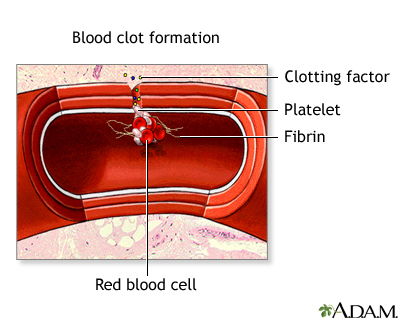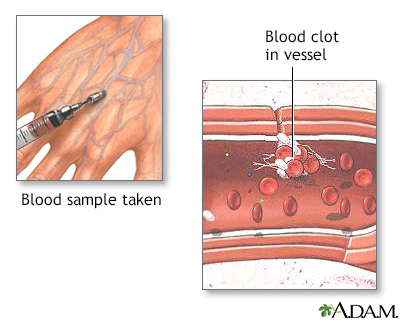Fibrinolysis - primary or secondary
Definition
Fibrinolysis is a normal body process. It prevents blood clots that occur naturally from growing and causing problems.
Primary fibrinolysis refers to the normal breakdown of clots.
Secondary fibrinolysis is the breakdown of blood clots due to a medical disorder, medicine, or other cause. This may cause severe bleeding.
Alternative Names
Primary fibrinolysis; Secondary fibrinolysis
Causes
Blood clots form on a protein called fibrin. The breakdown of fibrin (fibrinolysis) can be due to:
- Bacterial infections
- Cancer
- Intense exercise
- Not enough oxygen to tissues
Your health care provider may give you medicines to help blood clots break down more quickly. This may be done if a blood clot causes a heart attack.
Gallery


References
Brummel-Ziedins K, Mann KG. Molecular basis of blood coagulation. In: Hoffman R, Benz EJ, Silberstein LE, et al, eds. Hematology: Basic Principles and Practice. 7th ed. Philadelphia, PA: Elsevier; 2018:chap 126.
Schafer AI. Hemorrhagic disorders: disseminated intravascular coagulation, liver failure, and vitamin K deficiency. In: Goldman L, Schafer AI, eds. Goldman-Cecil Medicine. 26th ed. Philadelphia, PA: Elsevier; 2020:chap 166.
Weitz JI. Hemostasis, thrombosis, fibrinolysis, and cardiovascular disease. In: Libby P, Bonow RO, Mann DL, Tomaselli GF, Bhatt DL, Solomon SD, eds. Braunwald's Heart Disease: A Textbook of Cardiovascular Medicine. 12th ed. Philadelphia, PA: Elsevier; 2022:chap 95.